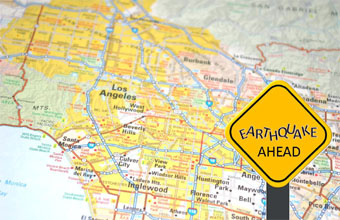
NASA: Chance of Major L.A. Quake 99%
| published October 23, 2015 |
By Keith H. Roberts, Thursday Review contributor
According to a new study released this week by NASA, Los Angeles can expect a major earthquake—that is a quake greater than magnitude 5.0—within the next three to five years. The detailed NASA report places the odds of a massive Southern California earthquake at 99%.
The NASA study, released earlier this week and based on digital analysis of GPS measurements, as well as radar and sonar measurements, was accompanied by parallel research from several universities and research centers, including the University of California at Irvine, UC Davis, and Indiana University in Bloomington.
The study found serious stress deformities left over from the March 2014 La Habra quake, which split streets and roads, shifted sidewalks, sliced through water mains and moved concrete objects. NASA and other researchers also concluded that intense stresses have built up along that same line, and will almost certainly lead to a major earthquake similar to La Habra within the next few years. NASA also concluded that there was a 35% chance of an even more powerful earthquake by 2018—one in the range of magnitude 6 and capable of far more destruction and loss of life than the La Habra quake.
The good news for people in the Los Angeles area: The U.S. Geological Survey questions the NASA study, and says it disputes the methodologies and the math used to arrive at the conclusions found in the new report. The Geological Survey says it places the chances of a magnitude 5 earthquake at “only” about 85% for the same period.
But in California, the sparring over the percentages is irrelevant. Several state agencies and university research teams consider the chances of a massive earthquake closer to 100%. Models and studies released by the Uniform California Earthquake Rupture Forecast say that based on its analysis, the people of Southern California can expect another magnitude 5 quake within the next several years. UCERF also predicts a massive 6.7 quake no later than within the next 30 years.
The disputes over percentages and math reveal the ability of geologists to more closely analyze the constantly-shifting earth; but the differences also reveal how much scientists still do not fully understand about earthquakes and their power. Los Angeles, and much of Southern California, sits atop a long set of fractures, part of a massive ring of shifting plates which surround much of the Pacific Ocean. In the U.S., the most notable of these lines is the San Andreas Fault, which runs for hundreds of miles, from an area south of San Francisco down to just north of Los Angeles; the San Andres Fault is part of a longer fault line which runs almost the entire length of California. The fault represents the tectonic intersection of two massive moving plates—the Pacific Plate and the North American Plate—which move laterally past each other, the Pacific Plate shifting south-southwest past the North American plate.
The fault line was first discovered in 1895 by Dr. Andrew Lawson, a professor at the University of California. At the time the fault was believed only to impact a small percentage of California, but over the following century scientists can to realize that the fracture extended the length of the state. The 1906 San Francisco Earthquake, which triggered one of the worst urban fires in U.S. history and killed more than 3,000 people, was the direct result of a massive shift along the fault line.
Related Thursday Review articles:
Chance of a Major California Quake Has Risen; Thursday Review staff; Thursday Review; March 12, 2015.
Yellowstone is Bigger Than We Thought; Thursday Review staff; Thursday Review; April 28, 2015.
